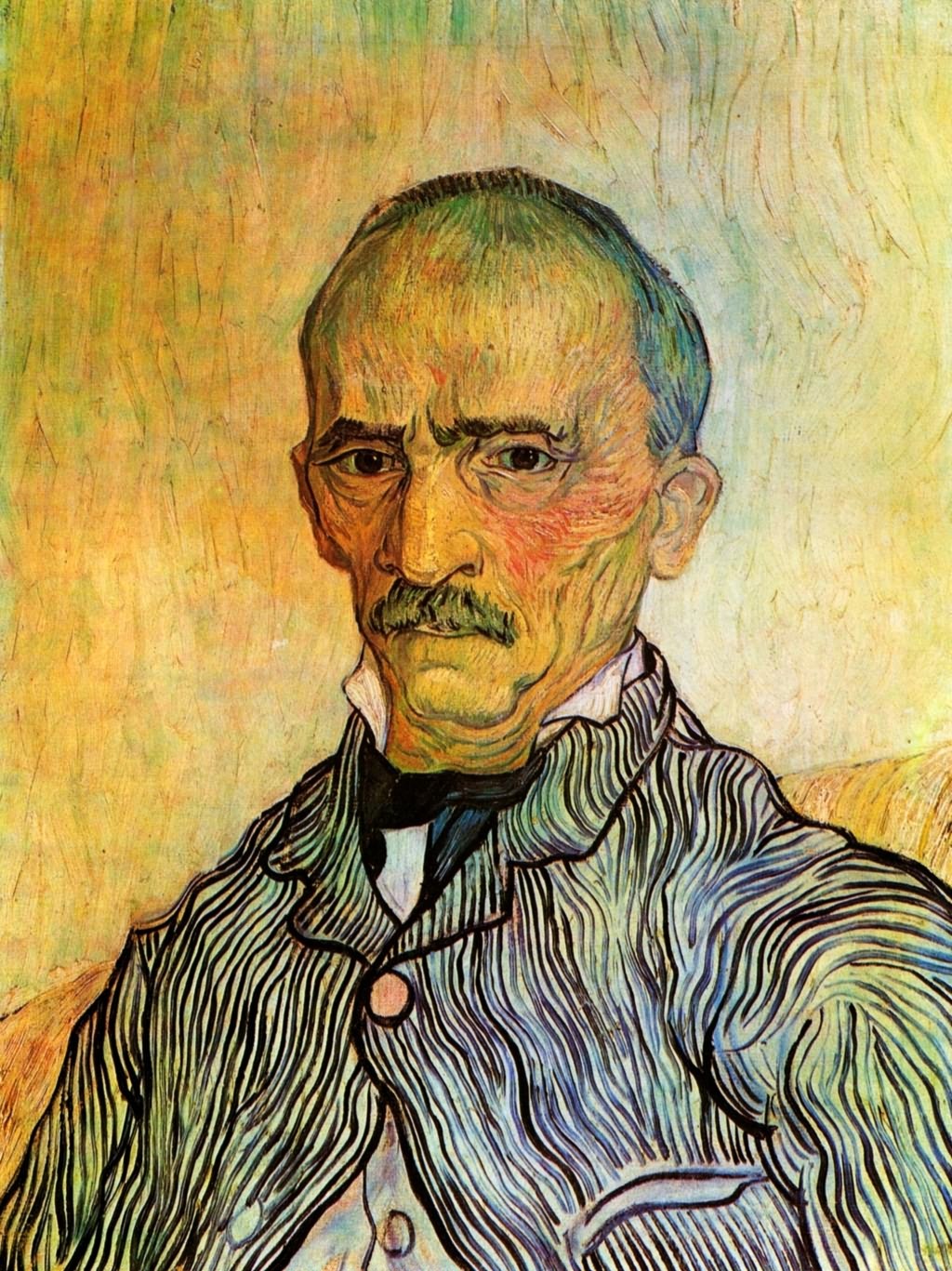Portrait of Trabuc, an Attendant at Saint-Paul Hospital
Appreciation

Portrait of Trabuc, an Attendant at Saint-Paul Hospital Nederland Vincent van Gogh Gallery and Appreciation
François Trabuc, who was the chief orderly at Saint-Paul, and his wife, Jeanne both sat for van Gogh. François Trabuc had a look of "contemplative calm" which van Gogh found interesting in spite of the misery he had witness at Saint-Paul and a Marseilles hospital during outbreaks of cholera. He wrote to Theo of Trabuc’s character, a military presence and "small keen black eyes". If it were not for his intelligence and kindness, his eyes could seem like that of a bird of prey.
Vincent van Gogh's two portraits of Charles-Elzéard Trabuc and his wife, Jeanne Lafuye Trabuc, are remarkable both in terms of their execution as well as their provenance.
Of Portrait of Trabuc, an Attendant at Saint-Paul Hospital Van Gogh wrote:
Yesterday I began the portrait of the head attendant, and perhaps I shall do his wife too, for he is married and lives in a little house a few steps away from the establishment.
A very interesting face, there is a fine etching by Legros, representing an old Spanish grandee, if you remember it, that will give you an idea of the type. He was at the hospital in Marseilles through two periods of cholera, altogether he is a man who has seen an enormous amount of suffering and death, and there is a sort of contemplative calm in his face, so that I can't help being reminded of Guizot's face--for there is something of that in his head, but different. But he is one of the people, and simpler. Anyway, you will see it if I succeed with it and if I make a duplicate.
Letter 604 Saint-Rémy 5 or 6 September 1889
Van Gogh enjoyed the company of Trabuc (or "the Major" as he was known to the inmates of the asylum). In fact, Van Gogh biographer David Sweetman suggests that "Trabuc had taken on the role of father figure and man-of-the-people from Roulin, who had in turn inherited it from old Tanguy."
In spite of Van Gogh's affinity for Mr. Trabuc, however, his comments about Trabuc's wife, written in his next letter to Theo, were far less sympathetic--bordering on the cruel:
I have done a portrait of the attendant, and I have a duplicate of it for you. This makes a rather curious contrast with the portrait I have done of myself, in which the look is vague and veiled, whereas he has something military in his small quick black eyes.
I have made him a present of it and I shall do his wife too if she wants to sit. She is a faded woman, an unhappy, resigned creature of small account, so insignificant that I have a great longing to paint that dusty blade of grass. I have talked to her sometimes when doing some olive trees behind their little house, and she told me then that she did not believe I was ill--and indeed, you would say the same thing yourself now if you could see me working, my brain so clear and my fingers so sure that I have drawn that "Pieta" by Delacroix without taking a single measurement.
Letter 605 Saint-Rémy 7 or 8 September 1889
The execution of the two works is indeed remarkable and Theo himself wrote that he found Mr. Trabuc's portrait "extraordinary" (Letter T33). Van Gogh scholar, Ronald Pickvance, comments on the work:
It was probably painted in one session, rapidly and thinly on an unprepared canvas, and not always to the edges. The figure was copied first; the background was then filled in with subtle infusions of turquoise and pink, the brushstrokes abutting the contours of the figure. In his references to the portrait, van Gogh never described the colour. And the colour, restrained and undramatic, seems subservient to the insistently linear patterns created in the coat and repeated in the head and neck and, more broadly and loosely, in the background articulation.
The provenance of the two portraits is interesting as well. First of all, neither of the paintings are originals. Van Gogh painted both portraits and then presented them to the Trabucs as gifts. Sadly, the originals have been lost, but Vincent also made copies of each of the two portraits for his brother, Theo. It is these copies which survive. The provenance of the portrait of Mrs. Trabuc is particularly intriguing in that it was reported as "lost" for decades, only re-emerging from obscurity in the mid-1990s. Otto Krebs, who acquired this painting from the Thannhauser Art Gallery in Berlin, kept it safely in a vault in his home near Weimar during World War II. It was then inherited by a foundation that Krebs had set up. Around 1947 a Russian officer, who had taken over Krebs house, opened the vault and then sent the contents to Leningrad (now St. Petersburg). There Portrait of Madame Trabuc stayed in a top secret depot at the Hermitage until the 1990s. Apparently even the director of the Hermitage wasn't aware of this depot and its contents.
Biographical Information
Charles-Elzéard Trabuc was born in Manosque, Basses-Alpes on 28 March 1830. He died in Saint-Rémy on 25 September 1896, six years after Van Gogh's death. His wife, Jeanne Lafuy Trabuc died in 1903.